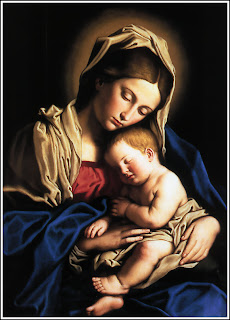MARY: A RESPONDING SELF

let me share some reflections of mine on Mary: A Responding Self.
In this scientific, technological and postmodern world, the self is always equated with individualism, i.e., we tend to look at self as individualistic. This outlook narrows down the whole reality to the individual or the person. In the recent past and at present, different philosophers are trying to broaden the understanding of the self or retrieve the notion of self from individualism in their own way by basing themselves on different realities. I, as a student of Mph and as a religious would like to retrieve the modern notion of self from atomism by looking at Mary, mother of Jesus, as the way opening to go beyond modern notion of self.
The term ‘respond’ comes for the Latin word ‘respondere’ and the French word ‘respondre’ meaning “to reply or to promise or to answer or to pledge”, i.e., to re-bond, to re-unite. When one responds tothe other, he/she becomes aware of the other or the basic bond that he/she has with the other, which guides the initial relationship with the other. And then this awareness leads the one to re-unite, re-bond him/herself with the other. I feel that the basic problem with the modern notion of self is that it does not take into consideration the basic bond that we have with the other and so recognizes the individual as the whole reality. Contrary to this, I see Mary as a self or person responding or recognizing the presence of the others, i.e., God, the source of our life,the immediate and significant other as the inner circle of our relationships or friendships and to the society or humanity itself as the outer circle of our relationships.
1. Mary: a responding self to God: Annunciation: (Luke1: 34-38)

Genesis tells us that all are created in the image and likeness of God. Therefore, there is by nature a bond between God and us, the creator of the world. We always live in this communion with God. Awareness of this communion or bond leads us to respond, re-unite, or reply to God. For Mary, this awareness was brought in an extraordinary way. Mary became completely aware of the natural bond between her and God at the annunciation. There she responded to re-unite herself with God by her ‘yes’ to angel Gabriel. She then kept on responding to him in various ways until the end of her life. In our case, we are not made aware of this natural bond between God and us in an extraordinary way. But the Church offers sacraments and ways of life to become aware of the presence of God. A sacrament is a call from God to respond or to re-unite ourselves with God. This is the first step to retrieve modern notion of self, which considers itself as God.
2. Mary: a responding self to the other: Visitation (Luke 1: 39-40, 56)

Our relationship or friendship is strengthened when we become aware of the presence of the other and respond to his/her being present with us. The visitation of Mary depicts the re-bonding with the immediate other, i.e., her inner circle of relationship. In the life of Mother Mary already there is a bond between her and Elizabeth. This bond is strengthened when Mary becomes aware or recognizes Elizabeth’s condition and goes to help. This is an invitation for us to create the inner circle of relationship by becoming aware of the other and re-bonding or re-uniting with the other. We can re-unite with the other only when we recognize the other. This is the second step to broaden the understanding of the modern notions of self.
3. Mary: a responding self to the society: Wedding at Cana (Jn 2: 3-5)

Charles Taylor says that we, human beings have two kinds of emotions. The first is the subject-referring emotions, i.e., feelings or emotions, which directly concern the subject. E.g., Our feeling of shame, anger, etc. The second is the self-referring emotions. It directly concerns the self or the subject. E.g., helping others who are in trouble. The act of helping appeals to individual’s motivation, which is self-regarding. Here, we feel called upon to help or an obligation to help. Mary’s extension to help at the wedding at Cana appeals to her motivation, i.e., the self-referring emotions. Mary feels called to help because it appeals to her self or person as human being. Here she recognizes the others’ need and re-bonds her-self with the others, i.e., society or humanity. This is the third step.
Dear friends, though we feel that we are not affected by this individualism externally but deep down in our heart, to a certain extent, we are affected by this modern notion of atomism. During this year, let us try to understand or become aware of those areas of our concern in which we indentify ourselves with the modern individualism and try to authentically retrieve them by recognizing the presence of the other, i.e., God, the immediate and significant other and the society the whole human race.
Comments
Post a Comment